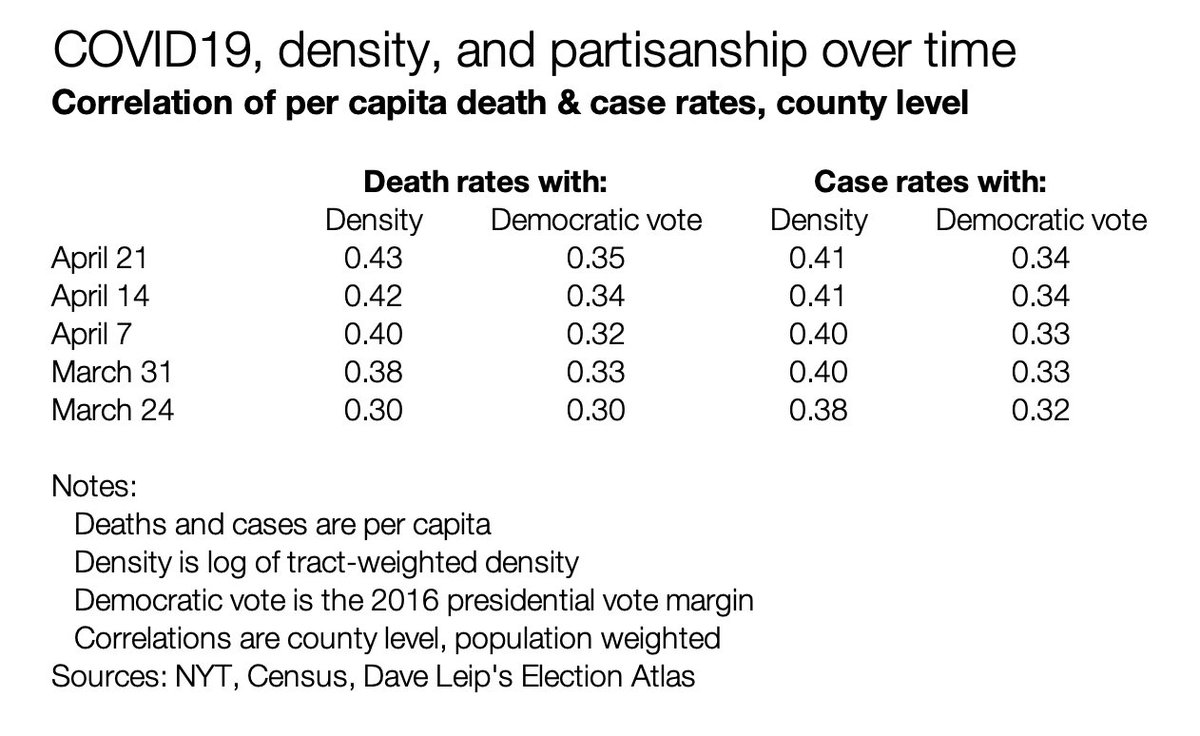I think the opposite is true. Short thread.
The relationship between death rates (and case rates) and (1) density and (2) partisanship has gotten slightly _stronger_ in recent weeks.
Here& #39;s the evidence, and why our analyses diverge.
1/ https://twitter.com/MarkMuro1/status/1253019865851494400">https://twitter.com/MarkMuro1...
The relationship between death rates (and case rates) and (1) density and (2) partisanship has gotten slightly _stronger_ in recent weeks.
Here& #39;s the evidence, and why our analyses diverge.
1/ https://twitter.com/MarkMuro1/status/1253019865851494400">https://twitter.com/MarkMuro1...
The correlation between deaths per capita (and cases per capita) and both density and 2016 Democratic vote share is positive and rising slightly in recent weeks.
My read is that the Brookings Metro piece looked at these data a very different way -- by describing the counties that crossed a fixed cases per capita threshold each week.
3/ https://www.brookings.edu/blog/the-avenue/2020/04/22/as-covid-19-spreads-newly-affected-areas-look-much-different-than-previous-ones/">https://www.brookings.edu/blog/the-...
3/ https://www.brookings.edu/blog/the-avenue/2020/04/22/as-covid-19-spreads-newly-affected-areas-look-much-different-than-previous-ones/">https://www.brookings.edu/blog/the-...
Counties that were hit hard early crossed that threshold first and can& #39;t cross it again. Naturally, places that cross that threshold later might look different demographically and politically than earlier places.
4/
4/
But local COVID19 effects aren& #39;t just about crossing a threshold. The case rate and death rate -- even after places cross a threshold -- matter. In fact, the effect may be non-linear in that a % increase from a higher base is worse because of the strain on the health system.
5/
5/
Yes, more places across the country seeing cases and deaths. But share of national deaths (and cases) in bluer, denser places is changing surprising little -- and if anything is rising slightly.
6/
6/
So yes, places now seeing large numbers of cases for the first time are less urban and less Democratic than places that got there first. But the rates in the more urban and Democratic places continue to rise at least as fast.
7/
7/
Counting places that cross a threshold ignores what happens to case and death rates after they cross that threshold. In many places, what happened since has been grim. That& #39;s essential to include in order to understand the spread -- and the politics -- of COVID19.
8/end
8/end

 Read on Twitter
Read on Twitter


